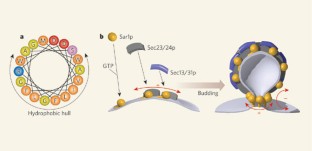Helices sculpt membrane (original) (raw)
- News & Views
- Published: 26 October 2005
Cell biology
Nature volume 437, pages 1247–1248 (2005)Cite this article
- 616 Accesses
- 9 Citations
- Metrics details
Many proteins are carried within cells in bubble-like sacs. These are pinched off from membranes inside the cell, and it seems that the Sar1p protein is key in both starting and finishing this budding process.
This is a preview of subscription content, access via your institution
Relevant articles
Open Access articles citing this article.
Access options
Subscribe to this journal
Receive 51 print issues and online access
$199.00 per year
only $3.90 per issue
Buy this article
- Purchase on SpringerLink
- Instant access to full article PDF
Prices may be subject to local taxes which are calculated during checkout
Additional access options:
Figure 1: Sar1p in budding and fission.

References
- McMahon, H. T. & Mills, I. G. Curr. Opin. Cell Biol. 16, 379–391 (2004).
Article CAS Google Scholar - Lee, M. C. S. et al. Cell 122, 605–617 (2005).
Article CAS Google Scholar - Matsuoka, K. et al. Cell 93, 263–275 (1998).
Article CAS Google Scholar - Hristova, K. et al. J. Mol. Biol. 290, 99–117 (1999).
Article CAS Google Scholar - Bi, X. et al. Nature 419, 271–277 (2002).
Article CAS ADS Google Scholar - Ford, M. G. et al. Nature 419, 361–366 (2002).
Article CAS ADS Google Scholar - Segrest, J. P. et al. J. Lipid Res. 33, 141–166 (1992).
CAS PubMed Google Scholar - Bigay, J., Casella, J. F., Drin, G., Mesmin, B. & Antonny, B. EMBO J. 24, 2244–2253 (2005).
Article CAS Google Scholar
Author information
Authors and Affiliations
- CNRS Institut de Pharmacologie Moléculaire et Cellulaire et Université de Nice, Sophia Antipolis, Valbonne, 06560, France
Guillaume Drin & Bruno Antonny
Authors
- Guillaume Drin
You can also search for this author inPubMed Google Scholar - Bruno Antonny
You can also search for this author inPubMed Google Scholar
Rights and permissions
About this article
Cite this article
Drin, G., Antonny, B. Helices sculpt membrane.Nature 437, 1247–1248 (2005). https://doi.org/10.1038/4371247a
- Published: 26 October 2005
- Issue Date: 27 October 2005
- DOI: https://doi.org/10.1038/4371247a